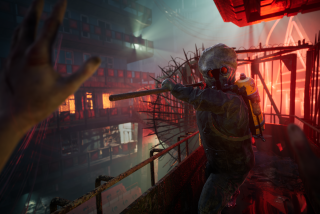The independent imagination
- Share via
It takes a certain mind-set to invent a gadget that causes a video game’s villains to start disco dancing.
For Insomniac Games, an independent studio in Burbank, the Groovitron is a signature touch -- zany, unexpected and over the top. Other wacky weapons in Insomniac’s latest game, “Ratchet & Clank Future: Tools of Destruction,” include the Transformer, which morphs enemies into cute penguins, and the Gelanator, which traps foes in cubes of lime gelatin.
Insomniac’s whimsical take has helped catapult nearly all of its titles to the top of the game industry’s bestseller charts, alongside titles produced by much larger and better-financed companies.
“There are very few places that have that sort of maniacal focus and unwillingness to compromise on quality,” said Mood Rowghani, a vice president at Summit Partners, a Boston-based private equity and venture capital firm. “These guys have it.”
With the average development budget for a commercially viable video game now more than $25 million, many studios have sought financial refuge by selling themselves to private equity firms or big publishers such as Electronic Arts Inc. or Activision Inc.
But Insomniac has remained one of a handful of developers that insist on dancing to their own funky tunes.
“Being independent is insurance that we can continue to make our own decisions,” said Ted Price, Insomniac’s 39-year-old founder and chief executive. “It lets us focus on making good games.”
It’s a familiar refrain with Price, who sang the virtues of independence in a 2002 article in The Times. Back then, Insomniac had 50 employees, and it cost less than $10 million to make a video game.
Now the company employs 150. Its game budgets have more than doubled, which means projects are riskier than ever. Developing games on next-generation consoles such as the PlayStation 3 and Xbox 360 can take as much money and manpower as a Hollywood movie.
That’s largely because much of the technology used in creating special effects in movies are the same ones used to create ultrarealistic graphics and lifelike animation in games.
Insomniac’s ability to survive as a stand-alone studio despite the surging costs stems partly from its relationship with Sony Corp., which bankrolls much of the firm’s projects and spends millions of dollars marketing its games. In return, Sony owns the intellectual property rights to the games, which can be played only on Sony’s PlayStation console.
The arrangement was lucrative for Insomniac when the console was dominant. But sales of the PlayStation 3 lag behind Nintendo Co.’s Wii and Microsoft Corp.’s Xbox 360, which means Insomniac now has fewer customers to buy its games.
“In some ways, Ted’s leaving money on the table by not publishing on any other platforms,” said Geoff Keighley, editor of the website Gameslice. “On the other hand, there’s something very noble in the fact that Ted has remained loyal to Sony through thick and thin. As the PS3 has struggled, Insomniac has kept pumping out the hits for Sony.”
Price sees it differently.
Although he wouldn’t rule out publishing a new game for other consoles one day, he said the PS3’s powerful graphics capability lined up well with Insomniac’s interest in making big, complex and visually lush games.
“It’s very symbiotic,” Price said. “We are great at making games. Sony’s great at publishing them. And everybody wins. This has gone back over 10 years. Since we’re independent, we don’t have to work with Sony, but we do because it’s gone extremely well.”
Sony’s financial backing also has meant that Insomniac never needed to go elsewhere for capital. Price continues to politely turn down every offer that comes his way.
Independent developers Pandemic Studios and BioWare Corp. recently sold out to Electronic Arts Inc. for a combined $775 million, but Price maintained he wasn’t interested in money.
“If we were to sell, things would change,” he said. “We like our size. It’s fool’s gold to assume that having more people adds to your success. Adding more people just adds to the chaos.”
Price found that out over the last five years, as his company tripled its head count.
He and his partners, worried they wouldn’t be able to keep control over a much larger company, took a private management course.
They incorporated some suggestions from the program, such as planning more for the long term and taking notes during meetings to keep track of the decisions made.
They chucked much of what they learned, however, preferring to return to their roots as a goofy, informal company that focuses on creativity and fun.
Insomniac has a Frag Fest Fridays tradition -- employees are expected to spend hours rocking out in “Guitar Hero,” exercising their vocal cords in “Sing Star” and playing other games. Price has taken his workers go-kart racing. Once, after meeting a particularly grueling deadline, he treated his employees and their families to a cruise to Mexico.
“What strikes me most about Insomniac is how much they haven’t changed,” Keighley said. “The Ted Price I met 12 years ago is largely the same one I know now. They’re surprisingly unaffected by everything that goes on around them. So many game companies are out hustling big movie deals. These guys just want to make games. They’re just very pure in their intent.”
Price exudes the same Eagle Scout’s optimism he did five years ago. He also bears the eagerness of someone who can’t quite believe he’s able to make video games for a living.
Price founded the company in 1994 with $30,000 from his savings and got help from Alex Hastings, a fellow graduate of Princeton University. The two later brought in Hastings’ older brother, Brian. It was possible then to create a splash in the video game industry with such modest resources.
The trio created a demo that earned them a contract to make their first title, a shooting game called “Disruptor.” It sold about 200,000 copies -- not great, but not shabby.
Their second game, “Spyro the Dragon,” featuring a kid-friendly purple dragon, was a runaway hit. From 1998 to 2000, the studio created three games based on Spyro, with sales approaching 12 million copies.
In 2002, the team created “Ratchet & Clank,” about a furry yellow creature and his robot sidekick. That franchise has sold more than 12 million copies, not counting the latest installment, which went on sale Oct. 30.
Insomniac took a different tack last year, when it released a darker, more mature game called “Resistance: Fall of Man,” which became one of the best-selling games for the PS3.
When asked what’s next, Brian Hastings, now chief creative officer, hinted at a new franchise for which Insomniac, and not Sony, would own the intellectual property.
“We want to keep on creating new things,” he said. “And we want to be able to control what we create.”
--
--
(BEGIN TEXT OF INFOBOX)
Action figures
Insomniac Games launched in 1998 with a game based on a kid-friendly purple dragon named Spyro. Since then, the studio’s games have sold more than 26 million copies. Here are some of its biggest hits, with the number of titles sold:
Spyro the Dragon series
“Spyro the Dragon” (1998): 4,832,145
“Spyro 2: Ripto’s Rage” (1999): 3,451,064
“Spryo: Year of the Dragon” (2000): 3,283,077
Ratchet & Clank series
(Sales through June 30, 2007)
“Ratchet & Clank” (2002): 3,714,266
“Ratchet & Clank: Going Commando” (2003): 2,966,758
“Ratchet & Clank: Up Your Arsenal” (2004): 3,218,932
“Ratchet Deadlocked” (2005): 2,169,858
“Ratchet & Clank Future: Tools of Destruction” (Released Oct. 30): No sales data available
“Resistance: Fall of Man”
(Sales through Sept. 30) 2,121,772
Sources: Insomniac Games, Sony Corp.
More to Read
The biggest entertainment stories
Get our big stories about Hollywood, film, television, music, arts, culture and more right in your inbox as soon as they publish.
You may occasionally receive promotional content from the Los Angeles Times.










